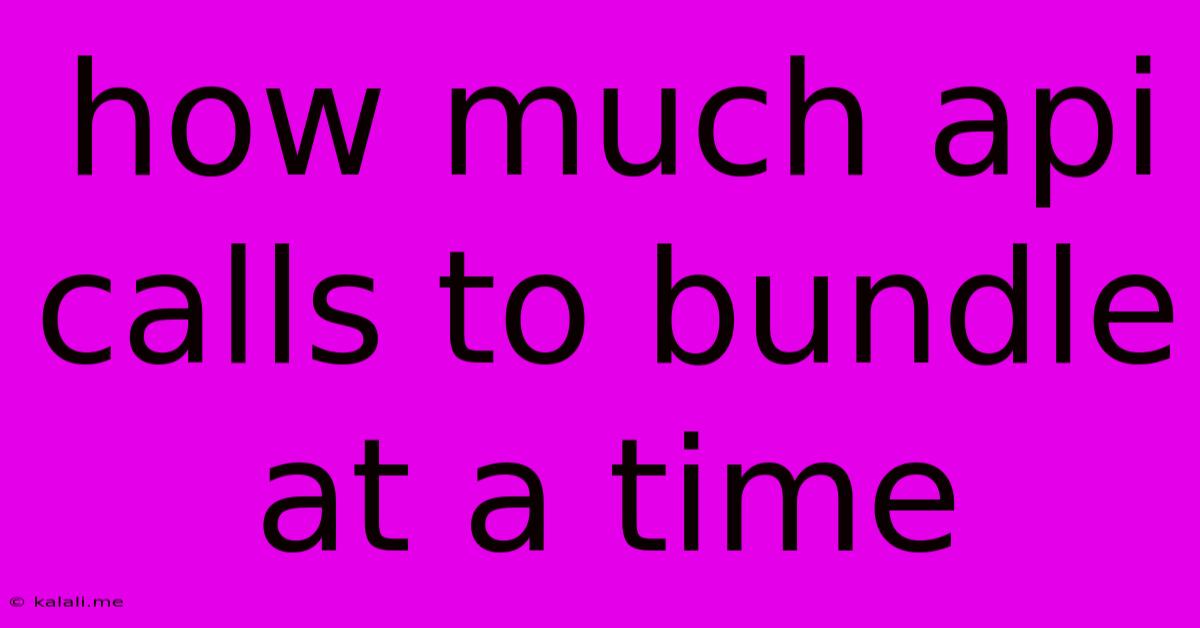How Much Api Calls To Bundle At A Time
Kalali
Jun 07, 2025 · 3 min read

Table of Contents
How Many API Calls to Bundle at a Time: Optimizing Your Application's Performance
Making efficient use of APIs is crucial for any application relying on external data sources. One key aspect of this efficiency is understanding how many API calls to bundle together in a single request. This article explores the optimal approach, balancing the benefits of batching with potential drawbacks. The ideal number isn't a fixed value; it depends heavily on your specific API, application needs, and the nature of the data being retrieved.
Understanding the Trade-offs: Batching API Calls
Batching, or bundling, multiple API calls into a single request offers significant performance advantages. By reducing the number of individual requests, you decrease:
- Latency: Fewer round trips to the server mean faster response times for your application. This directly translates to a better user experience, especially for applications with high throughput.
- Network Overhead: Each API call involves establishing a connection, sending data, receiving a response, and closing the connection. Batching significantly reduces this overhead.
- Server Load: Fewer requests mean less load on the API server, contributing to overall system stability and potentially improving performance for all users.
However, there are limitations to consider:
- API Limits: Most APIs have rate limits, restricting the number of requests per second or minute. Exceeding these limits can lead to temporary blocks or even permanent bans.
- Payload Size: API requests have size limits. Very large batches can exceed these limits, leading to request failures.
- Error Handling: With bundled requests, a single error can affect the entire batch. Careful error handling is crucial to manage these situations gracefully.
- Complexity: Implementing batching adds complexity to your application code.
Determining the Optimal Batch Size:
The optimal batch size is a balance between the benefits and drawbacks mentioned above. Here's a step-by-step approach to determining the best value for your application:
-
Consult the API Documentation: Check the API's documentation for guidance on batching. Many APIs explicitly support batch requests, often specifying maximum batch sizes and recommended practices. This is the most reliable starting point.
-
Experimentation: Start with a small batch size (e.g., 2-5 requests) and gradually increase it while monitoring response times and error rates. Use a robust monitoring system to track key metrics.
-
Consider Data Dependencies: If the requests are independent, you can batch them more aggressively. However, if there are dependencies between requests (e.g., one request depends on the result of another), batching might be less efficient or even impossible.
-
Analyze Payload Size: Keep an eye on the total payload size of your batch requests. If you approach the API's size limits, you'll need to reduce the batch size.
-
Implement Robust Error Handling: Your code should gracefully handle errors within batches, potentially retrying failed requests individually or implementing fallback mechanisms.
-
Monitor Performance: Continuously monitor your application's performance after implementing batching. Track metrics like response time, error rate, and throughput to ensure your changes are improving performance, not hindering it.
Example Scenarios and Considerations:
-
Fetching User Data: If you need to fetch data for multiple users, batching is highly beneficial. You could fetch data for 10-20 users in a single request, significantly improving efficiency.
-
Processing Images: If you're processing many images using an image recognition API, batching is a common and effective optimization technique. However, you'll need to consider the size of the images and the API's payload limits.
Conclusion:
The optimal number of API calls to bundle at a time is context-dependent. By carefully considering API limitations, data dependencies, and implementing robust error handling, you can significantly improve your application's performance and efficiency through intelligent batching. Remember that continuous monitoring and experimentation are crucial for finding the sweet spot for your specific needs.
Latest Posts
Latest Posts
-
Cant Use Suica Galaxy Watch 6
Jun 07, 2025
-
Print Pdf With Line Numbers And Page Numbers
Jun 07, 2025
-
Best Noise Cancelling Ear Muffs For Planes
Jun 07, 2025
-
I Dont Have To Show No Stinking Badges
Jun 07, 2025
-
How To Know What Parts Were Replaced On Refurbished Earbuds
Jun 07, 2025
Related Post
Thank you for visiting our website which covers about How Much Api Calls To Bundle At A Time . We hope the information provided has been useful to you. Feel free to contact us if you have any questions or need further assistance. See you next time and don't miss to bookmark.